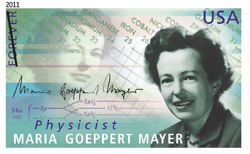A stamp of her own
 |
| Photo: US Postal Service |
Maria Goeppert Mayer left an indelible stamp on the history of physics. Now the US Postal Service has honored the nuclear physicist with a stamp of her own.
Goeppert Mayer was the second woman to win the Nobel Prize in Physics and only the fourth to win a Nobel in any scientific field.
In 1946, while splitting her time between Argonne National Laboratory and what is now the University of Chicago's Enrico Fermi Institute, she became interested in the mystery of “magic numbers:” Atomic nuclei that contain certain numbers of neutrons or protons are more stable than others, but no one knew why.
Physicists had already theorized that electrons orbit the nucleus in layers, or “shells,” based on their energies. Goeppert Mayer set about proving that protons and neutrons, collectively known as nucleons, also occupy shells within the nucleus. Much as the Earth spins on its axis while orbiting the sun, nucleons spin on their axes while moving in a larger orbit. Magic numbers result when a particular shell is full of nucleons. With a full shell, the atom is less likely to interact and is thus more stable.
For the discovery of the nuclear shell model and spin-orbit coupling, which allowed scientists to explain previously baffling observations about the atom, Goeppert Mayer shared half the Nobel Prize in Physics with J. Hans D. Jensen in 1963. Her first-class postage stamp is part of a series called “American Scientists” that can be purchased online.
You can find out more about her work at the “Contributions of 20th Century Women to Physics” website,http://cwp.library.ucla.edu.
Louise Lerner
Click here to download the pdf version of this article.






